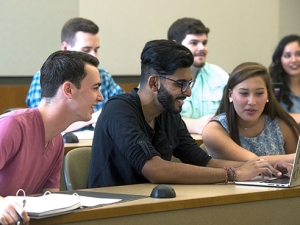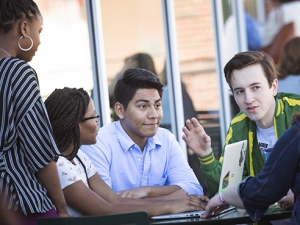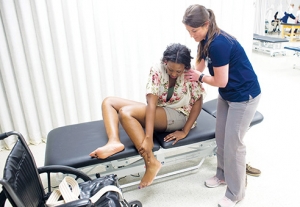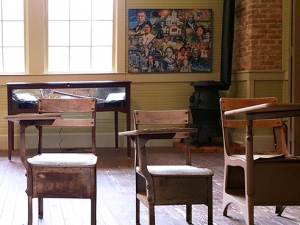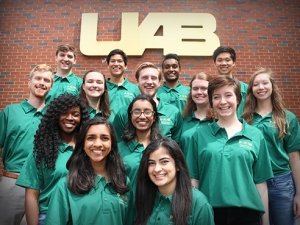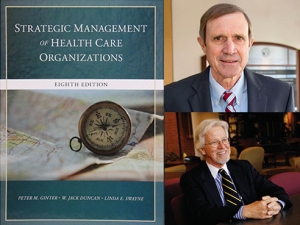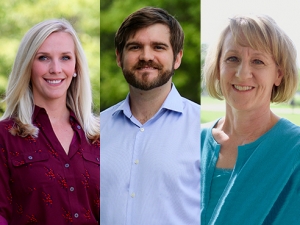David Shealy, Ph.D., is a scientist. And he’s a scientist who loves his research — whether it involves last beam shaping, geometrical optics, grid computing or optical design.
 |
| David Shealy, left, and Paul Gamlin were among several faculty members to lead the charge in UAB acquiring a campuswide Mathworks® software license. |
In 2009, Shealy, chair of the Department of Physics, began looking at the number of licenses of Mathworks® software purchased by UAB investigators. Mathworks is a high-level language, interactive environment that enables researchers to perform computationally intensive tasks faster than with traditional programming languages such as C, C++ and Fortran.
He realized a universitywide site license would cost less than individual licenses combined and provide all the toolkits the software offers to every faculty and staff member.
So the Office of the Vice President for Research and Economic Development, the schools of Medicine, Optometry, Public Health and Engineering and the College of Arts & Sciences pooled their resources to buy the large, generally usable software tool in January. The purchase, which totaled a little more than $50,000, makes UAB the first university in Alabama to implement a Mathworks Total Academic Headcount (TAH) license, which enables every employee affiliated with UAB to use MATLAB and Simulink software and any of its 48 toolboxes and block-sets on university-owned computers.
“It makes it easier to do science when you have the tools you need,” Shealy says. “It’s important that UAB students, researchers, faculty and staff have access to the leading computational scientific simulation tools in a wide collection of disciplines that other research universities have. We need to be competitive. We need to have the same tools. Some of us had them before; all of us have them now.”
The license allows unlimited use of MATLAB in both teaching and research activities. Only full-time faculty and staff can install the full collection of MATLAB and any of the 48 toolboxes and block-sets on their computers for UAB work. Students can use Mathworks software on UAB computers on campus.
MATLAB, short for Matrix Laboratory, is the world’s leading developer of technical computing software for engineers and scientists.
MATLAB allows matrix manipulations, plotting of functions and data, implementation of algorithms, creation of user interfaces and interfacing with programs written in other languages, including C, C++ and Fortran. An additional package, Simulink, adds graphical multi-domain simulation and Model-Based Design for dynamic and embedded systems.
MATLAB can be used on personal computers and powerful server systems, including the UAB Cheaha (docs.uabgrid.uab.edu/wiki/Cheaha) computer cluster, which supports high-performance computing and high-throughput computing paradigms and is the primary interface for leveraging computational resources on UABgrid, the campus distributed research support infrastructure.
With the addition of the Parallel Computing Toolbox, the language can be extended with parallel implementations for common computational functions, including for-loop unrolling. Additionally, this toolbox supports offloading computationally intensive workloads to Cheaha. Jobs that could take 20 hours running on an office computer can be run in 30 minutes to an hour if submitted to a cluster.
“This may seem like a small thing to make a big deal about, but this is putting significant scientific computing infrastructure in place,” says Paul Gamlin, Ph.D., professor and chair of Vision Sciences. “You can have a great high-speed performance computer, but if you don’t have the software to do anything on it, you’re stuck. Imagine having a computer on your desk without Microsoft Word. What do you do?
“This is basically the software environment that enables us to develop programs to analyze any scientific data you can think of,” Gamlin says. “It’s an environment to facilitate research and let investigators do what we have to do to do our jobs efficiently and effectively.”
Almost 260 employees had individual licenses before the sitewide purchase, including Kristina Visscher, Ph.D., assistant professor of neurobiology.
In her neuroscience research, Visscher uses fMRI and EEG methods to examine changes in brain activity based on the task a person is preparing to do. Her lab studies neural activity before a stimulus, such as a visual image, affects the way we process or remember it later.
“That means we collect a huge amount of data from an individual participant, Visscher says. “We are collecting a person’s brain activity during viewing, literally hundreds of images, and we need to be able to process that data. MATLAB is great for that, and there are other researchers all around the world who write code in MATLAB and share it with everyone, so we can also use it for our data analysis.”
In fact, Gamlin says so much shareware is available through MATLAB that many researchers can usually find someone who has written code that they in turn can use for their projects.
“MATLAB is a really open environment,” Gamlin says. “It enables you to do the basic science really quickly and then do more innovative science as you need.”
Visscher says researchers who haven’t used MATLAB will find that the software can open up their data to faster and more flexible analyses than many other packages.
“It’s flexible, so we can use it for generating our experiments, and for analyzing all the different types of data that we have,” Visscher says. “This is great for us because we integrate a lot of different data — behavioral data about how long it takes participants to react, eye tracking data indicating what they are looking at, fMRI data indicating with good spatial precision the parts of the brain are active during a condition and EEG data, indicating with good temporal precision the way the brain reacts to a stimulus.”
Thomas Foley, information systems manager II in Engineering, helped Shealy, Gamlin and Visscher push for the universitywide license. He says faculty in his school are excited to see the full MATLAB product available.
For example, Hassan Moore, Ph.D., assistant professor of mechanical engineering, teamed with Douglas Ross, assistant professor of mechanical engineering, on the topics of Mathematics, Physics, Engineering and Computer Science converge in their Computer Methods in Engineering course.
“MATLAB certainly makes it easy to design freshman-level engineering assignments and projects,” Moore says.
In fact, Engineering trains all of its students to use MATLAB the first semester they are in school, and they use the software throughout their time at UAB. Shealy thinks that is important, and he hopes to lead physics faculty down a similar path to include MATLAB more in physics courses.
“You have to give students the necessary tools to properly prepare them to go out and compete in science, engineering and technology,” he says. “This is a boon for UAB researchers and students, and it is a clear example where research administration worked with many other schools to pull together the resources to buy this cutting-edge tool.”
There are many tutorials, how-to and frequently asked questions (FAQs) landing pages on MATLAB to help researchers. Mathworks staff also will visit UAB up to three times per year for training sessions.
To learn more about MATLAB and how you can use it at UAB, visit docs.uabgrid.uab.edu/wiki/MATLAB. For more information, contact Shealy at dls@uab.edu or 934-8068.

